Diatom and Dinocyst Production, Composition and Flux from the Annual Cycle Sediment Trap Study in the Barents Sea
Abstract
1. Introduction
2. Materials and Methods
3. Results
3.1. Environmental Parameters at the Mooring Site
3.2. Monthly Changes of Sea-Ice Covers and Seasonal Cycle of Solar Light Availability
3.3. Mass, Carbon and Total Fluxes
3.4. Diatom Fluxes and Assemblages
3.5. NPP, Pollen and Spores Fluxes and Assemblages
3.6. Relation of Diatoms and Dinocyst Species to Light Availability, SIC, POC and N fluxes
4. Discussion
4.1. The Specifics of Obtaining and Interpreting High-Latitude Sediment Trap Data
4.2. The Role of Sea-Ice Cover and Light Availability
4.3. The Influx of Relatively Warm-Water Species as A Result of the Barents Sea Atlantification
5. Conclusions
Supplementary Materials
Author Contributions
Funding
Institutional Review Board Statement
Informed Consent Statement
Data Availability Statement
Acknowledgments
Conflicts of Interest
References
- Sakshaug, E. Biomass and productivity distributions and their variability in the Barents Sea. ICES J. Mar. Sci. 1997, 54, 341–350. [Google Scholar] [CrossRef]
- Schauer, U.; Loeng, H.; Rudels, B.; Ozhigin, V.K.; Dieck, W. Atlantic water Flow through the Barents and Kara Seas. Deep-Sea Res. Part I. Oceanogr. Res. Pap. 2002, 49, 2281–2298. [Google Scholar] [CrossRef]
- Lind, S.; Ingvaldsen, R.B. Variability and impacts of Atlantic Water entering the Barents Sea from the north. Deep-Sea Res. Part I. 2012, 62, 70–88. [Google Scholar] [CrossRef]
- Pisarev, S.V. Review of the Barents Sea hydrological conditions. In The Barents Sea System; Lisitzin, A.P., Ed.; GEOS: Moscow, Russia, 2021; pp. 153–166, (In Russian). [Google Scholar] [CrossRef]
- Oziel, L.; Sirven, J.; Gascard, J.-C. The Barents Sea frontal zones and water masses variability (1980–2011). Ocean Sci. 2016, 12, 169–184. [Google Scholar] [CrossRef]
- Gordeev, V.V.; Demina, L.L.; Alekseeva, T.N. Some geochemical features of the major element composition of the surface bottom sediments of the Barents Sea. In The Barents Sea System; Lisitzin, A.P., Ed.; GEOS: Moscow, Russia, 2021; pp. 415–430, (In Russian). [Google Scholar] [CrossRef]
- Sakshaug, E.; Skjoldal, H.R. Life at the ice edge. Ambio 1989, 18, 60–67. [Google Scholar]
- Vinje, T.; Kvambekk, A.S. Barents Sea drift ice characteristics. Polar Res. 1991, 10, 59–68. [Google Scholar] [CrossRef]
- Backhaus, J.O.; Wehde, H.; Nøst Hegseth, E.; Kämpf, J. Phyto-convection: The role of oceanic convection in primary production. Mar. Ecol. Prog. Ser. 1999, 189, 77–92. [Google Scholar] [CrossRef]
- Wassmann, P.; Ratkova, T.N.; Andreassen, I.J.; Vernet, M.; Pedersen, G.; Rey, F. Spring bloom development in the marginal ice zone and the central Barents Sea. Mar. Ecol. 1999, 20, 321–346. [Google Scholar] [CrossRef]
- Zernova, V.V.; Shevchenko, V.P.; Vetrov, A.A.; Politova, N.V. Distribution of phytoplankton and suspended organic matter in the Barents Sea in autumn 1997. Arkt. Antarkt. 2005, 4, 115–129. (In Russian) [Google Scholar]
- Zernova, V.V.; Shevchenko, V.P.; Politova, N.V. Features of the phytoene structure of the Barents Sea over a meridional section at 37–40°E (September 1997). Oceanology 2003, 43, 395–403. [Google Scholar]
- Pautova, L.A. Phytoplankton of the Barents Sea. In The Barents Sea System; Lisitzin, A.P., Ed.; GEOS: Moscow, Russia, 2021; pp. 317–330, (In Russian). [Google Scholar] [CrossRef]
- Loeng, H. Features of the physical oceanographic conditions of the Barents Sea. Polar Res. 1991, 10, 5–18. [Google Scholar] [CrossRef]
- Pavlov, V.K.; Pfirman, S.L. Hydrographic structure and variability of the Kara Sea: Implications for pollutant distribution. Deep Sea Res. Part II Top. Stud. Oceanogr. 1995, 42, 1369–1390. [Google Scholar] [CrossRef]
- Cloern, J.E.; Jassby, A.D. Complex seasonal patterns of primary producers at the land–sea interface. Ecol. Lett. 2008, 11, 1294–1303. [Google Scholar] [CrossRef]
- Marinov, I.; Doney, S.C.; Lima, I.D. Response of ocean phytoplankton community structure to climate change over the 21st century: Partitioning the effects of nutrients, temperature and light. Biogeosciences 2010, 7, 3941–3959. [Google Scholar] [CrossRef]
- Heikkilä, M.; Pospelova, V.; Forest, A.; Stern, G.A.; Fortier, L.; Macdonald, R.W. Dinoflagellate cyst production over an annual cycle in seasonally ice-covered Hudson Bay. Mar. Micro. 2016, 125, 1–24. [Google Scholar] [CrossRef]
- Diatoms of the USSR (Fossil and Modern); Science: Moscow/Leningrad, Russia, 1974; 403p. (In Russian)
- Loseva, E.I. Beautiful Invisible Diatoms; Ural Division RAS: Yekaterinburg, Russia, 2002; 146p. (In Russian) [Google Scholar]
- Kiselev, I.A. On the distribution and composition of phytoplankton in the Barents Sea. Proc. Inst. Study North. 1928, 37, 28–42. [Google Scholar]
- Roukhiyainen, M.I. Vertical distribution of phytoplankton in the southern part of the Barents Sea. In Composition and Distribution of Plankton and Benthos in the Southern Part of the Barents Sea; Science: Moscow/Leningrad, Russia, 1966; pp. 24–33. [Google Scholar]
- Ardyna, M.; Babin, M.; Gosselin, M.; Devred, E.; Rainville, L.; Tremblay, J.-E. Recent Arctic Ocean sea ice loss triggers novel fall phytoplankton blooms. Geophys. Res. Lett. 2014, 41, 6207–6212. [Google Scholar] [CrossRef]
- Polyakova, Y.I.; Pavlidis, Y.A.; Levin, A.I. Peculiarities of formation of diatoms thanatocenoses in the surface layer of bottom sediments of the Barents Sea shelf. Oceanology 1992, 32, 166–175. [Google Scholar]
- Polyakova, Y.I. Arctic Seas of Eurasia in the Late Cenozoic; Scientific World: Moscow, Russia, 1997; 145p. (In Russian) [Google Scholar]
- Voronina, E.; Polyak, L.; de Vernal, A.; Peyron, O. Holocene variations of sea-surface conditions in the southeastern Barents sea, reconstructed from dinoflagellate cyst assemblages. J. Quat. Sci. 2001, 16, 717–726. [Google Scholar] [CrossRef]
- Harland, R. Recent dinoflagellate cyst assemblages from the Southern Barents Sea. Palynology 1982, 6, 9–18. [Google Scholar] [CrossRef]
- Zonneveld, K.A.F.; Marret, F.; Versteegh, G.J.M.; Bogus, K.; Bonnet, S.; Bouimetarhan, I.; Crouch, E.; de Vernal, A.; Elshanawany, R.; Edwards, L.; et al. Atlas of modern dinoflagellate cyst distribution based on 2405 data points. Rev. Palaeobot. Palynol. 2013, 191, 1–197. [Google Scholar] [CrossRef]
- Dzhinoridze, R.N. Diatoms in bottom sediments of the Barents Sea. In Marine Micropaleontology: Diatoms, Radiolarians, Silicoflagellates, Foraminifers and Calcareous Nanoplankton; Nauka: Moscow, Russia, 1978; pp. 41–44. [Google Scholar]
- Kagan, L.Y. Diatom analysis of late Cenozoic deposits of the Arctic seas. In Newest deposits and paleogeography of the northern seas; Publishing House of the KSC of the Academy of Sciences of the USSR: Apatity, Russia, 1989; pp. 83–93. [Google Scholar]
- Ivanova, E.; Murdmaa, I.; de Vernal, A.; Risebrobakken, B.; Peyve, A.; Brice, C.; Seitkalieva, E.; Pisarev, S. Postglacial paleoceanography and paleoenvironments in the northwestern Barents Sea. Quat. Res. 2019, 92, 430–449. [Google Scholar] [CrossRef]
- Brice, C.; de Vernal, A.; Ivanova, E.; van Bellen, S.; Van Nieuwenhove, N. Palynological evidence of sea-surface conditions in the Barents Sea off Northeast Svalbard during the postglacial period. Quat. Res. 2020, 108, 1–15. [Google Scholar] [CrossRef]
- Mudie, P.J.; Marret, F.; Gurdebeke, P.R.; Hartman, J.D.; Reid, P.C. Marine dinocysts, acritarchs and less well-known NPP: Tintinnids, ostracod and foraminiferal linings, copepod and worm remains. Geol. Soc. Spec. Publ. 2021, 511, 159–232. [Google Scholar] [CrossRef]
- Taylor, F.J.R.; Pallingher, U. Ecology of dinoflagellates. In The Biology of Dinoflagellates Botanical Monographs, Vol. 21.; Taylor, F.J.R., Ed.; Blackwell Scientific: Oxford, UK, 1987; pp. 399–529. [Google Scholar]
- Klenova, M.V. Geology of the Barents Sea; AN SSSR: Moscow/Leningrad, Russia, 1960; 367p. [Google Scholar]
- Polyakova, Y.I.; Novichkova, E.A.; Agafonova, E.A. Diatoms and aquatic palynomorphs in the bottom sediments of the Barents Sea: Main patterns of distribution and use in paleooceanological studies. In The Barents Sea System, Lisitzin, A.P.; GEOS: Moscow, Russia, 2021; pp. 64–95, (In Russian). [Google Scholar] [CrossRef]
- Bogus, K.; Mertens, K.N.; Lauwaert, J.; Harding, I.C.; Vrielinck, H.; Zonneveld, K.A.F.; Versteegh, G.J.M. Differences in the chemical composition of organic-walled dinoflagellate resting cysts from phototrophic and heterotrophic dinoflagellates. J. Phycol. 2014, 50, 254–266. [Google Scholar] [CrossRef]
- Honjo, S.; Manganini, S.J.; Krishfield, R.A.; Francois, R. Particulate organic carbon fluxes to the ocean interior and factors controlling the biological pump: A synthesis of global sediment trap programs since 1983. Prog. Oceanogr. 2008, 76, 217–285. [Google Scholar] [CrossRef]
- Honjo, S.; Krishfield, R.A.; Eglinton, T.I.; Manganini, S.J.; Kemp, J.N.; Doherty, K.; Hwangac, J.; McKee, T.K.; Takizawa, T. Biological pump processes in the cryopelagic and hemipelagic Arctic Ocean: Canada Basin and Chukchi Rise. Prog. Oceanogr. 2010, 85, 137–170. [Google Scholar] [CrossRef]
- Lisitzin, A.P. Marine ice-rafting as a new type of sedimentogenesis in the Arctic and novel approaches to studying sedimentary processes. Russ. Geol. Geophys. 2010, 51, 12–47. [Google Scholar] [CrossRef]
- Drits, A.V.; Klyuvitkin, A.A.; Kravchishina, M.D.; Novigatsky, A.N.; Karmanov, V.A. Fluxes of Sedimentary Material in the Lofoten Basin of the Norwegian Sea: Seasonal Dynamics and the Role of Zooplankton. Oceanology 2020, 60, 501–517. [Google Scholar] [CrossRef]
- Andreassen, I.J.; Wassmann, P. Vertical flux of phytoplankton and particulate biogenic matter in the marginal ice zone of the Barents Sea in May 1993. Mar. Ecol. Prog. Ser. 1998, 170, 1–14. [Google Scholar] [CrossRef][Green Version]
- Coppola, L.; Roy-Barman, M.; Wassmann, P.; Mulsow, S.; Jeandel, C. Calibration of sediment traps and particulate organic carbon export using 234Th in the Barents Sea. Mar. Chem. 2002, 80, 11–26. [Google Scholar] [CrossRef]
- Olli, K.; Wexels Riser, C.; Wassmann, P.; Ratkova, T.; Arashkevich, E.; Pasternak, A. Seasonal variation in vertical flux of biogenic matter in the marginal ice zone and the central Barents Sea. J. Mar. Syst. 2002, 38, 189–204. [Google Scholar] [CrossRef]
- Reigstad, M.; Wexels Riser, C.; Wassmann, P.; Ratkova, T. Vertical export of particulate organic carbon: Attenuation, composition and loss rates in the northern Barents Sea. Deep. Sea Res. Part II: Top. Stud. Oceanogr. 2008, 55, 2308–2319. [Google Scholar] [CrossRef]
- Klyuvitkin, A.A.; Novigatsky, A.N.; Politova, N.V.; Bulokhov, A.V.; Kravchishina, M.D. Vertical particle fluxes in the Barents Sea on materials of short-time operation of automatic deep-water sedimentary observatory. In Proceedings of the 28th International Symposium on Atmospheric and Ocean Optics: Atmospheric Physics, Tomsk, Russia, 4–8 July 2022; Volume 12341, pp. 992–997. [Google Scholar]
- Shevchenko, V.P.; Ivanov, G.I.; Burovkin, A.A.; Dzhinoridze, R.N.; Zernova, V.V.; Polyak, L.V.; Shanin, S.S. Sedimentary material flows in the St. Anna Trough and eastern Barents Sea. Dokl. Earth Sci. 1998, 359, 400–403. [Google Scholar]
- Zernova, V.V.; Nöthig, E.-M.; Shevchenko, V.P. Vertical mircoalga flux in the northern Laptev Sea (from the data collected by the Yearlong Sediment trap). Oceanology 2000, 40, 801–808. [Google Scholar]
- Fahl, K.; Nöthig, E.-M. Lithogenic and biogenic particle fluxes on the Lomonosov Ridge (central Arctic Ocean) and their relevance for sediment accumulation: Vertical vs. lateral transport. Deep Sea Res. Part I: Oceanogr. Res. Pap. 2007, 54, 1256–1272. [Google Scholar] [CrossRef]
- Politova, N.V.; Shevchenko, V.P.; Zernova, V.V. Distribution, composition, and vertical fluxes of particulate matter in bays of Novaya Zemlya Archipelago, Vaigach Island at the end of summer. Adv. Meteorol. 2012, 2012, 259316. [Google Scholar] [CrossRef]
- Lalande, C.; Nöthig, E.-M.; Somavilla, R.; Bauerfeind, E.; Shevchenko, V.; Okolodkov, Y. Variability in under-ice export fluxes of biogenic matter in the Arctic Ocean. Glob. Biogeochem. Cycles 2014, 28, 571–583. [Google Scholar] [CrossRef]
- Nöthig, E.-M.; Lalande, C.; Fahl, K.; Metfies, K.; Salter, I.; Bauerfeind, E. Annual cycle of downward particle fluxes on each side of the Gakkel Ridge in the central Arctic Ocean. Philos. Trans. R. Soc. 2020, 378, 2181. [Google Scholar] [CrossRef]
- Gaye, B.; Fahl, K.; Kodina, L.A.; Lahajnar, N.; Nagel, B.; Unger, D.; Gebhardt, A.C. Particulate matter fluxes in the southern and central Kara Sea compared to sediments: Bulk fluxes, amino acids, stable carbon and nitrogen isotopes, sterols and fatty acids. Cont. Shelf Res. 2007, 27, 2570–2594. [Google Scholar] [CrossRef]
- Drits, A.V.; Kravchishina, M.D.; Sukhanova, I.N.; Belyaev, N.A.; Karmanov, V.A.; Flint, M.V. Seasonal Variability in the Sedimentary Matter Flux on the Shelf of the Northern Kara Sea. Oceanology 2021, 61, 984–993. [Google Scholar] [CrossRef]
- Lind, S.; Ingvaldsen, R.B.; Furevik, T. Arctic warming hotspot in the northern Barents Sea linked to declining sea-ice import. Nat. Clim. Change 2018, 8, 634–639. [Google Scholar] [CrossRef]
- Schlichtholz, P. Subsurface ocean flywheel of coupled climate variability in the Barents Sea hotspot of global warming. Sci. Rep. 2019, 9, 692. [Google Scholar] [CrossRef]
- Skagseth, Ø.; Eldevik, T.; Årthun, M.; Asbjørnsen, H.; Lien, V.S.; Smedsrud, L.H. Reduced efficiency of the Barents Sea cooling machine. Nat. Clim. Change 2020, 10, 661–666. [Google Scholar] [CrossRef]
- Asbjørnsen, H.; Årthun, M.; Skagseth, Ø.; Eldevik, T. Mechanisms underlying recent Arctic Atlantification. Geophys. Res. Lett. 2020, 47, e2020GL088036. [Google Scholar] [CrossRef]
- Barton, B.I.; Lenn, Y.-D.; Lique, C. Observed Atlantification of the Barents Sea Causes the Polar Front to Limit the Expansion of Winter Sea Ice. J. Phys. Oceanogr. 2018, 48, 1849–1866. [Google Scholar] [CrossRef]
- Polyakova, Y.I. Diatoms of Arctic seas of the USSR and their significance in the study of bottom sediments. Oceanology 1988, 28, 221–225. [Google Scholar]
- Polyakova, Y.I.; Novichkova, Y.A.; Klyuvitkina, T.S. Diatoms and palynomorphs in surface sediments of the Arctic seas and their significance for paleoceanological studies at high latitudes. In The White Sea System. Vol. IV The Processes of Sedimentation, Geology and History; Lisitzin, A.P., Shevchenko, V.P., Vorontsova, V.G., Eds.; Scientific World: Moscow, Russia, 2017; pp. 796–859. (In Russian) [Google Scholar]
- Matthiessen, J.; de Vernal, A.; Head, M.; Okolodkov, Y.; Zonneveld, K.; Harland, R. Modern organic-walled dinoflagellate cysts in Arctic marine environments and their (paleo-) environmental significance. Palaeontologische Zietschrift. 2005, 79, 3–51. [Google Scholar] [CrossRef]
- Matthiessen, J.; Schreck, M.; De Schepper, S.; Coralie, Z.; de Vernal, A. Quaternary dinoflagellate cysts in the Arctic Ocean: Potential and limitations for stratigraphy and paleoenvironmental reconstructions. Quat. Sci. Rev. 2018, 192, 1–26. [Google Scholar] [CrossRef]
- Kravchishina, M.D.; Novigatskii, A.N.; Savvichev, A.S.; Pautova, L.A.; Lisitsyn, A.P. Studies on sedimentary systems in the Barents Sea and Norwegian–Greenland basin during cruise 68 of the R/V Akademik Mstislav Keldysh. Oceanology 2019, 59, 158–160. [Google Scholar] [CrossRef]
- Novigatsky, A.N.; Gladyshev, S.V.; Klyuvitkin, A.A.; Kozina, N.V.; Artemev, V.A.; Kochenkova, A.I. Multidisciplinary research in the North Atlantic and Arctic on cruise 71 of the R/V Akademik Mstislav Keldysh. Oceanology 2019, 59, 464–466. [Google Scholar] [CrossRef]
- Lisitsyn, A.P.; Lukashin, V.N.; Novigatskii, A.N.; Ambrosimov, A.; Klyuvitkin, A.; Filippov, A. Deep-water observatories in the Trans-Caspian cross section: Continuous studies of scattered sedimentary matter. Dokl. Earth Sci. 2014, 456, 709–713. [Google Scholar] [CrossRef]
- Klyuvitkin, A.A.; Novigatsky, A.N.; Politova, N.V.; Koltovskaya, E.V. Studies of sedimentary matter fluxes along a long-term transoceanic transect in the North Atlantic and Arctic interaction area. Oceanology 2019, 59, 411–421. [Google Scholar] [CrossRef]
- Battarbee, R.W. A new method for estimation of absolute microfossil numbers, with reference especially to diatoms. Limnol. Oceanogr. 1973, 18, 647–653. [Google Scholar] [CrossRef]
- Novigatsky, A.N.; Lisitsyn, A.P.; Shevchenko, V.P.; Klyuvitkin, A.A.; Kravchishina, M.D.; Politova, N.V. Vertical fluxes of settling particles in the Arctic Ocean. In The Barents Sea System; Lisitzin, A.P., Ed.; GEOS: Moscow, Russia, 2021; pp. 278–286, (In Russian). [Google Scholar] [CrossRef]
- Round, F.E.; Crawford, R.M.; Mann, D.G. The Diatoms. Biology and Morphology of the Genera; Cambridge University Press: Cambridge, UK, 1990; p. 747. [Google Scholar]
- Krammer, K. Diatoms of Europe: Diatoms of the European Inland Waters and Comparable Habitats; Lange-Bertalot, H., Ed.; A.R.G. Gantner Verlag K.G.: Ruggell, Liechtenstein, 2003; Volume 4, 584p. [Google Scholar]
- Witkowski, A.; Lange-Bertalot, H.; Metzeltin, D. Diatom Flora of Marine Coasts I. Iconographia Diatomologica; A.R.G. Gantner Verlag K.G.: Ruggell, Liechtenstein, 2000; Volume 7, 925p. [Google Scholar]
- Fourtanier, E.; Kociolek, J.P. Catalogue of the diatom genera. Diatom Res. 1999, 14, 1–190. [Google Scholar] [CrossRef]
- Jahn, R.; Kusber, W.-H. (Eds.) AlgaTerra Information System. Botanic Garden and Botanical Museum. Berlin-Dahlem, Freie Universität Berlin. Annotated List of Diatom Names by Horst Lange-Bertalot and Coworker. Available online: http://160.45.63.31/Names_Version3_0.pdf (accessed on 21 October 2022).
- Morphbank: Biological Imaging. Florida State University, Department of Scientific Computing, Tallahassee, FL 32306-4026 USA. Available online: https://www.morphbank.net/ (accessed on 21 October 2022).
- Spaulding, S.A.; Potapova, M.; Bishop, I.W.; Lee, S.; Gasperak, T.; Jovanovska, E.; Furey, P.C.; Edlund, M.B. Diatoms.org: Supporting taxonomists, connecting communities. Diatom Res. 2021, 4, 291–304. [Google Scholar] [CrossRef]
- Guiry, M.D.; Guiry, G.M.; AlgaeBase. World-Wide Electronic Publication, National University of Ireland, Galway. Available online: http://www.algaebase.org (accessed on 21 October 2022).
- Klyuvitkina, T.S.; Novichkova, E.A. Laboratory processing in the aquatic palynomorph analysis: Problems and solutions. Oceanology 2022, 62, 270–277. [Google Scholar] [CrossRef]
- Stockmarr, J. Tablets with spores used in absolute pollen analysis. Pollen Spores 1971, 13, 615–621. [Google Scholar]
- Fensome, R.A.; Taylor, F.J.R.; Norris, G.; Sarjeant, W.A.S.; Wharton, D.I.; Williams, G.L. A classification of living and fossil dinoflagellates. American Museum of Natural History. Micropaleontology 1993, 7, 1–351. [Google Scholar]
- Van Nieuwenhove, N.; Head, M.J.; Limoges, A.; Pospelova, V.; Mertens, K.N.; Matthiessen, J.; De Schepper, S.; de Vernal, A.; Eynaud, F.; Londeix, L.; et al. An overview and brief description of common marine organic-walled dinoflagellate cyst taxa occurring in surface sediments of the Northern Hemisphere. Mar. Micropaleontol. 2020, 159, 101814. [Google Scholar] [CrossRef]
- Limoges, A.; Van Nieuwenhove, N.; Head, M.J.; Mertens, K.N.; Pospelova, V.; Rochon, A. A review of rare and less well known extant marine organic-walled dinoflagellate cyst taxa of the orders Gonyaulacales and Suessiales from the Northern Hemisphere. Mar. Micropaleontol. 2020, 159, 101801. [Google Scholar] [CrossRef]
- Mertens, K.N.; Gu, H.; Gurdebeke, P.R.; Takano, Y.; Clarke, D.; Aydin, H.; Li, Z.; Pospelova, V.; Shin, H.H.; Li, Z.; et al. A Review of rare, poorly known, and morphologically problematic extant marine organic-walled dinoflagellate cyst taxa of the orders Gymnodiniales and Peridiniales from the Northern Hemisphere. Mar. Micropaleontol. 2020, 159, 101773. [Google Scholar] [CrossRef]
- Dolan, J.R.; Pierce, R.W.; Yang, E.J. Tintinnid ciliates of the marine microzooplankton in Arctic seas: A compilation and analysis of species records. Polar Biol. 2017, 40, 1247–1260. [Google Scholar] [CrossRef]
- Ter Braak, C.J.F.; Smilauer, P. CANOCO Reference Manual and User’s Guide to Canoco for Windows: Software for Canonical Community Ordination (version 5.15) Paperback—January 1, 1998; Centre for Biometry: Lausanne, Switzerland, 1998. [Google Scholar]
- U.S. National Ice Center Arctic and Antarctic Sea Ice Concentration and Climatologies in Gridded Format, Version 1 | National Snow and Ice Data Center. Compiled by F. Fetterer and J. S. Stewart. 2020. Available online: https://nsidc.org/data/G10033/versions/1 (accessed on 29 August 2022).
- Arctic and Antarctic Research Institute. Available online: https://www.aari.ru/departments/tsentr-ledovoi-gidrometeorologicheskoi-informatsii (accessed on 29 August 2022).
- NASA Worldview. Available online: https://worldview.earthdata.nasa.gov (accessed on 22 October 2022).
- The 10.7cm Solar Flux Data are Provided as a Service by the National Research Council of Canada. Available online: http://www.drao.nrc.ca/index_eng.shtml (accessed on 21 October 2022).
- NOAA. Physical Science Laboratory. Monthly Climate Timeseries: Solar Flux (10.7cm). Available online: https://psl.noaa.gov/data/timeseries/monthly/SOLAR (accessed on 21 October 2022).
- Tapping, K.F. The 10.7 cm solar radio flux (F10.7). Space Weather 2013, 11, 394–406. [Google Scholar] [CrossRef]
- Stein, A.F.; Draxler, R.R.; Rolph, G.D.; Stunder, B.J.B.; Cohen, M.D.; and Ngan, F. NOAA’s HYSPLIT atmospheric transport and dispersion modeling system. Bull. Amer. Meteor. Soc. 2015, 96, 2059–2077. [Google Scholar] [CrossRef]
- Rolph, G.; Stein, A.; Stunder, B. Real-time Environmental Applications and Display sYstem: READY. Environ. Model. Softw. 2017, 95, 210–228. [Google Scholar] [CrossRef]
- READY - Real-time Environmental Applications and Display sYstem. Available online: https://www.ready.noaa.gov/index.php (accessed on 22 October 2022).
- Rat’kova, T.; Wassmann, P. Seasonal variation and spatial distribution of phytoplankton protozooplankton in the central Barents Sea. Journ. Marine Syst. 2002, 38, 47–75. [Google Scholar] [CrossRef]
- Melnikov, I.A.; Dikarev, S.N.; Egorov, V.G.; Kolosova, E.G.; Zhitina, L.S. Structure of the coastal ice ecosystem in the river-sea interaction zone. Oceanology 2005, 45, 511–519. [Google Scholar]
- Usachov, P.I. Microflora of polar ice. Proceedings of Oceanology Institut of USSR Academy of Science 1949, 3, 216–259. (In Russian) [Google Scholar]
- Horner, R. Arctic sea-ice biota. In The Arctic Seas. Climatology, Oceanography. Geology, and Biology; Herman, Y., Ed.; Van Nostrand Reinhold: New York, NY, USA, 1989; pp. 123–146. [Google Scholar]
- Rochon, A.; de Vernal, A.; Turon, J.-L.; Matthiessen, J.; Head, M.J. Distribution of recent dinoflagellate cysts in surface sediments from the North Atlantic ocean and adjacent seas in relation to sea-surface parameters. Am. Assoc. Stratigr. Palynol. 1999, 35, 1–146. [Google Scholar] [CrossRef]
- De Vernal, A.; Radi, T.; Zaragosi, S.; Van Nieuwenhove, N.; Rochon, A.; Allan, E.; De Schepper, S.; Eynaud, F.; Head, M.J.; Limoges, A.; et al. Distribution of common modern dinoflagellate cyst taxa in surface sediments of the Northern Hemisphere in relation to environmental parameters: The new N = 1968 database. Mar. Micropaleontol. 2020, 159, 101796. [Google Scholar] [CrossRef]
- De Vernal, A.; Rochon, A.; Fréchette, B.; Henry, M.; Radi, T.; Solignac, S. Reconstructing past sea ice cover of the northern hemisphere from dinocyst assemblages: Status of the approach. Quat. Sci. Rev. 2013, 79, 122–134. [Google Scholar] [CrossRef]
- Grøsfjeld, K.; Harland, R.; Howe, J. Dinoflagellate cyst assemblages inshore and offshore Svalbard reflecting their modern hydrography and climate. Nor. Geol. Tidsskr. 2009, 89, 121–134. [Google Scholar]
- Solignac, S.; Grosfjeld, K.; Giraudeau, J.; de Vernal, A. Distribution of recent dinocyst assemblages in the Western Barents Sea. Nor. Geol. Tidsskr. 2009, 89, 109–119. [Google Scholar]
- Howe, J.A.; Harland, R.; Cottier, F.R.; Brand, T.; Willis, K.J.; Berge, J.R.; Grøsfjeld, K.; Eriksson, A. Dinoflagellate cysts as proxies for palaeoceanographic conditions in Arctic fjords. Geol. Soc. Lond. Spec. Publ. 2010, 344, 61–74. [Google Scholar] [CrossRef]
- Stoecker, D.K.; Gustafson, D.E.; Merrell, J.R.; Black, M.M.D.; Baier, C.T. Excystment and growth of chrysophytes and dinoflagellates at low temperatures and high salinities in Antarctic sea-ice. J. Phycol. 1997, 33, 585–595. [Google Scholar] [CrossRef]
- Montresor, M.; Lovejoy, C.; Orsini, L.; Procaccini, G.; Roy, S. Bipolar distribution of the cyst-forming dinoflagellate Polarella glacialis. Polar Biol. 2003, 26, 186–194. [Google Scholar] [CrossRef]
- Montresor, M.; Procaccini, G.; Stoecker, D.K. Polarella glacialis, gen. nov., sp. nov. (Dinophyceae): Suessiaceae are still alive! J. Phycol. 1999, 35, 186–197. [Google Scholar] [CrossRef]
- Hegseth, E.N.; von Quillfeldt, C. The sub-ice algal communities of the Barents Sea pack ice: Temporal and spatial distribution of biomass and species. J. Mar. Sci. Eng. 2022, 10, 164. [Google Scholar] [CrossRef]
- Heikkilä, M.; Pospelova, V.; Hochheim, K.P.; Kuzyk, Z.Z.A.; Stern, G.A.; Barber, D.G.; Macdonald, R.W. Surface sediment dinoflagellate cysts from the Hudson Bay system and their relation to freshwater and nutrient cycling. Mar. Micropaleontol. 2014, 106, 79–109. [Google Scholar] [CrossRef]
- Kraus, M.; Matthiessen, J.; Stein, R. A Holocene marine pollen record from the northern part Yenisei Estuary (southeastern Kara Sea, Siberia). In Siberian River Run-Off in the Kara Sea; Stein, R.K., Fahl, D.K., Futterer, E.M., Galimov, O.V., Stepanets, G., Eds.; Elsevier: Amsterdam, The Netherlands, 2003; pp. 433–456. [Google Scholar]
- Kuznetsov, A.A.; Shoshina, E.V. Phytocenoses of the Barents Sea (Physiological and Structural Characteristics); KSC RAN: Apatity, Russia, 2003; 308p. [Google Scholar]
- Poulin, M.; Daugbjerg, N.; Gradinger, R.; Ilyash, L.; Ratkova, T.; von Quillfeldt, C. The Pan-Arctic biodiversity of marine pelagic and sea-ice unicellular eukaryotes: A first-attempt assessment. Mar. Biodivers. 2011, 41, 13–28. [Google Scholar] [CrossRef]
- De Vernal, A.; Henry, M.; Matthiessen, J.; Mudie, P.J.; Rochon, A.; Boessenkool, K.P.; Eynaud, F.; Grosfjeld, K.; Guiot, J.; Hamel, D.; et al. Dinoflagellate cyst assemblages as tracers of sea-surface conditions in the northern North Atlantic, Arctic and Sub-Arctic seas: The new “n = 677” data base and its application for quantitative palaeoceanographic reconstruction. J. Quat. Sci. 2001, 16, 681–698. [Google Scholar] [CrossRef]
- Okolodkov, Y.B.; Dodge, J.D. Biodiversity and biogeography of planktonic dinoflagellates in the Arctic Ocean. J. Exp. Mar. Biol. Ecol. 1996, 202, 19–27. [Google Scholar] [CrossRef]
- Head, M.J. Modern dinoflagellate cysts and their biological affinities, p. 1197–1248. In Palynology: Principles and Applications; Jansonius, J., McGregor, D.C., Eds.; American Association of Stratigraphic Palynologists Foundation: Dallas, TX, USA, 1996; Volume 3. [Google Scholar]
- Penaud, A.; Hardy, W.; Lambert, C.; Marret, F.; Masure, E.; Servais, T.; Siano, R.; Wary, M.; Mertens, K.N. Dinoflagellate fossils: Geological and biological applications. Rev. Micropaleontol. 2018, 61, 235–254. [Google Scholar] [CrossRef]
- Bauerfeind, E.; Nöthig, E.M.; Beszczynska, A.; Fahl, K.; Kaleschke, L.; Kreker, K.; Klages, M.; Soltwedel, T.; Lorenzen, C.; Wegner, J. Particle sedimentation patterns in the eastern Fram Strait during 2000–2005: Results from the Arctic long-term observatory HAUSGARTEN. Deep. Res. Part I Oceanogr. Res. 2009, 56, 1471–1487. [Google Scholar] [CrossRef]
- Wassmann, P.; Egge, J.K.; Reigstad, M.; Aksnes, D.L. Influence of dissolved silicate on vertical flux of particulate biogenic matter. Mar. Pollut. Bull. 1997, 33, 10–21. [Google Scholar] [CrossRef]
- Krause, J.; Duarte, C.M.; Marquez, I.A.; Assmy, P.; Fernandez-Mendez, M.; Wiedmann, I.; Wassmann, P.; Kristiansen, S.; Agusti, S. Biogenic silica production and diatom dynamics in the Svalbard region during spring. Biogeosciences 2018, 15, 6503–6517. [Google Scholar] [CrossRef]
- Wassmann, P. Vernal export and retention of biogenic matter in the north-eastern North Atlantic and adjacent Arctic Ocean: The role of the Norwegian Atlantic Current and topography. Mem. Natl. Inst. Polar Res. 2001, 54, 377–392. [Google Scholar]
- Årthun, M.; Eldevik, T.; Smedsrud, L.H.; Skagseth, O.; Ingvaldsen, R.B. Quantifying the influence of Atlantic heat on Barents Sea ice variability and retreat. J. Clim. 2012, 25, 4736–4743. [Google Scholar] [CrossRef]
- Polyakov, I.V.; Pnyushkov, A.V.; Alkire, M.B.; Ashik, I.M.; Baumann, T.M.; Carmack, E.C.; Goszczko, I.; Guthrie, J.; Ivanov, V.V.; Kanzow, T.; et al. Greater role for Atlantic inflowson sea-ice loss in the Eurasian Basin of the Arctic Ocean. Science 2017, 356, 285–291. [Google Scholar] [CrossRef]
- Semina, G.I. Phytoplankton of the Pacific Ocean; Science: Moscow, Russia, 1974; 239p. [Google Scholar]
- Dmitrenko, I.A.; Rudels, B.; Kirillov, S.A.; Aksenov, Y.O.; Lien, V.S.; Ivanov, V.V.; Shauer, U.; Polyakov, I.V.; Coward, A.; Barber, D.G. Atlantic water flow into the Arctic Ocean through the St. AnnaTrough in the northern Kara Sea. J. Geophys. Res. Oceans 2015, 120, 5158–5178. [Google Scholar] [CrossRef]
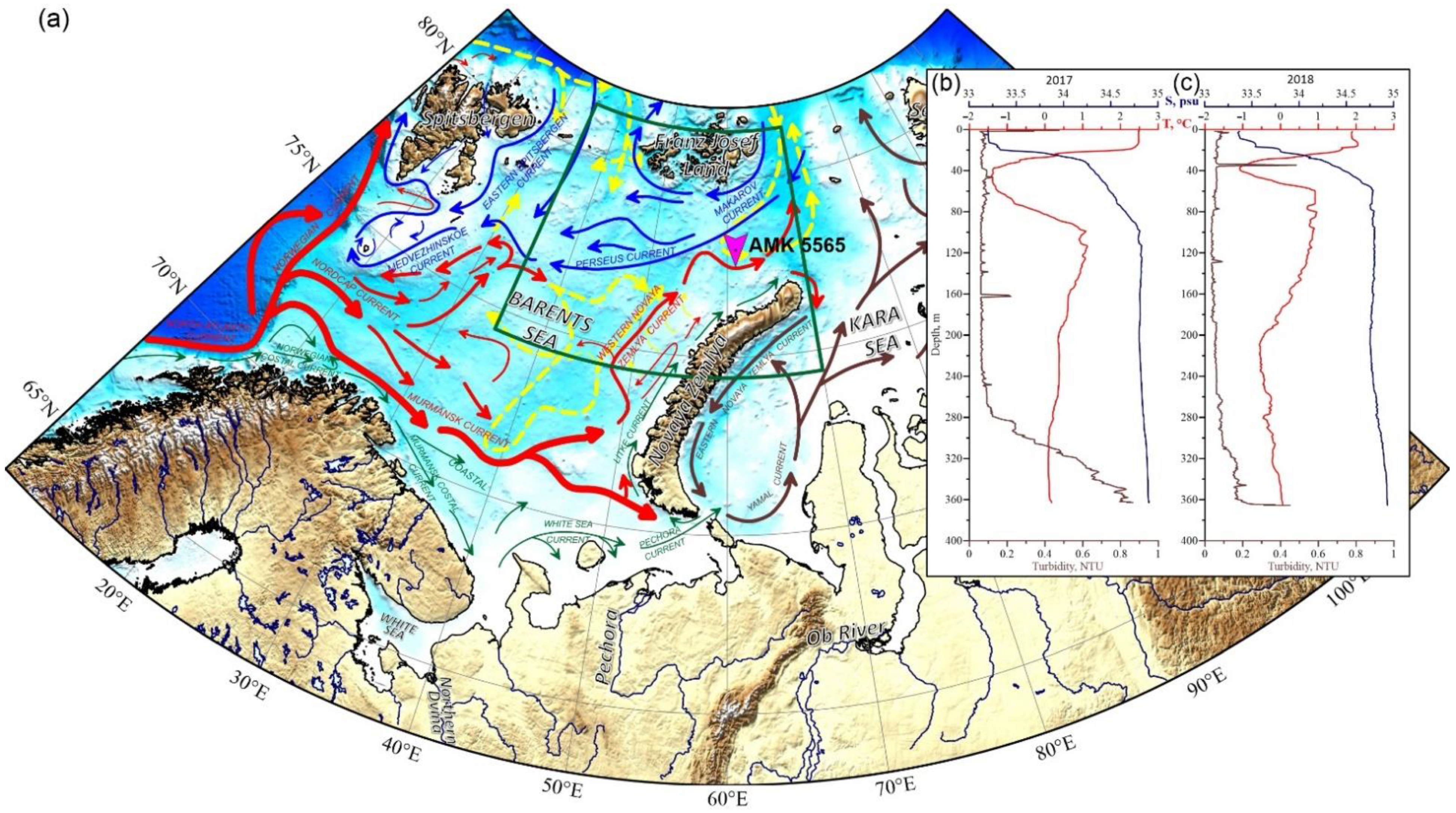
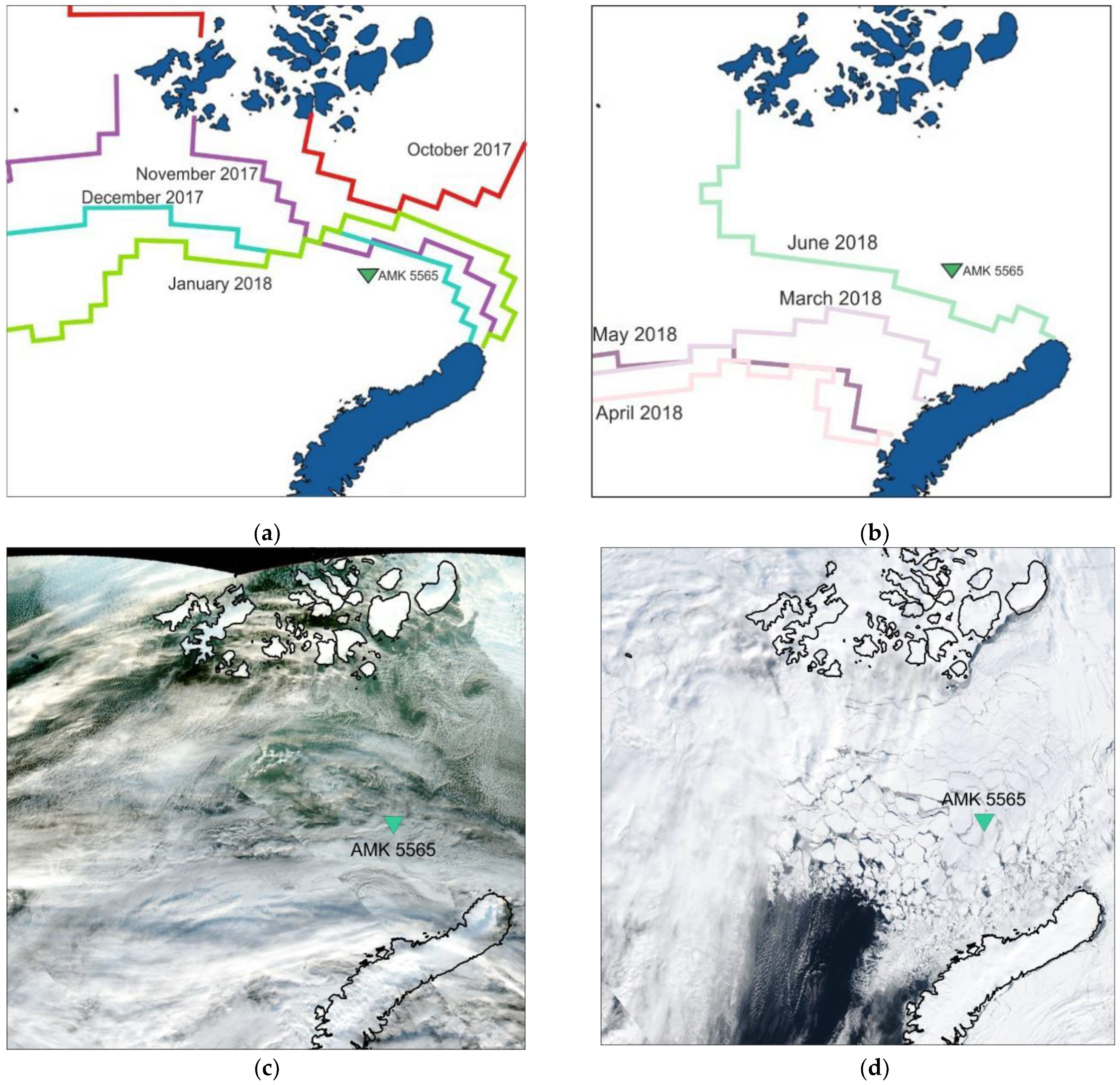
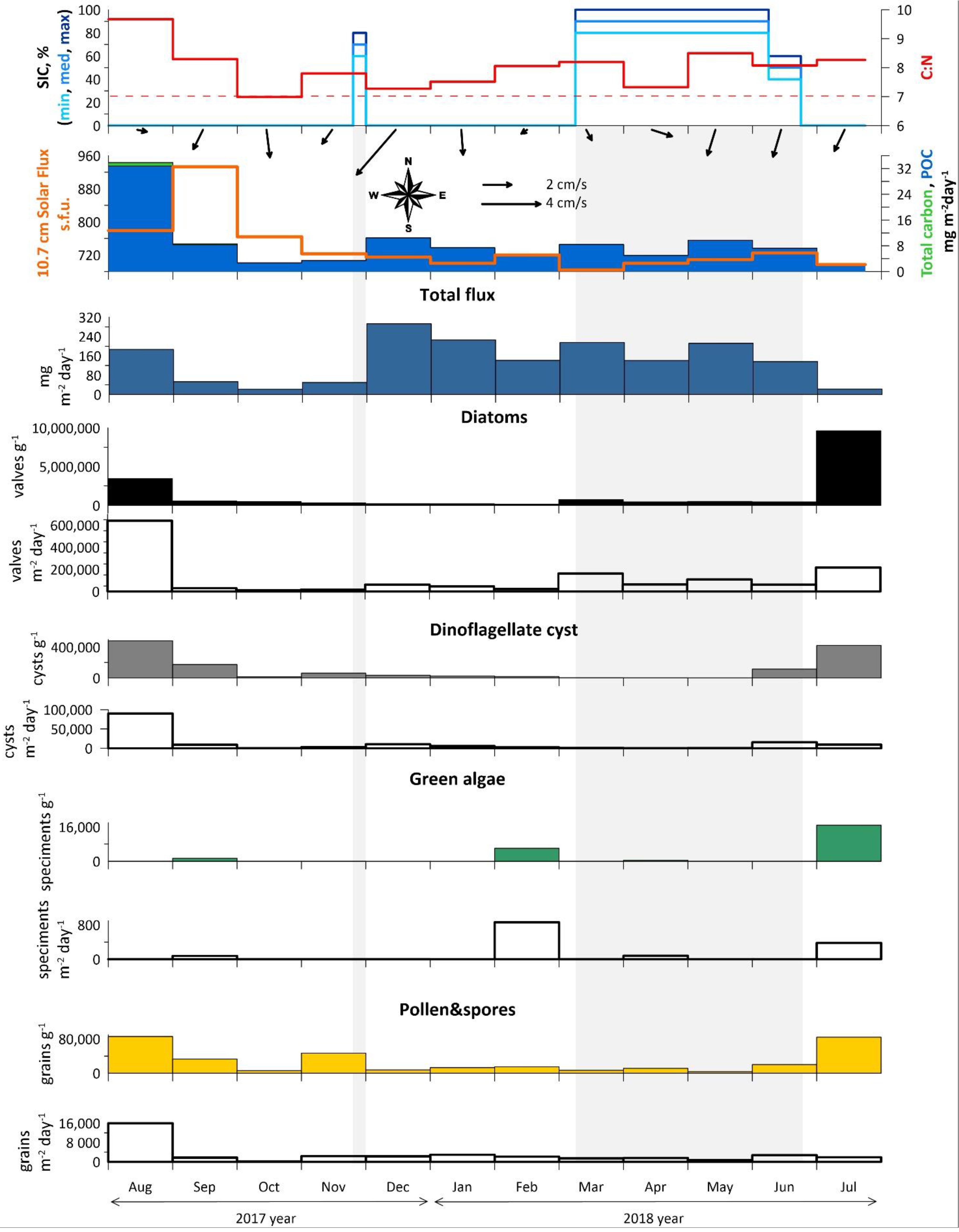

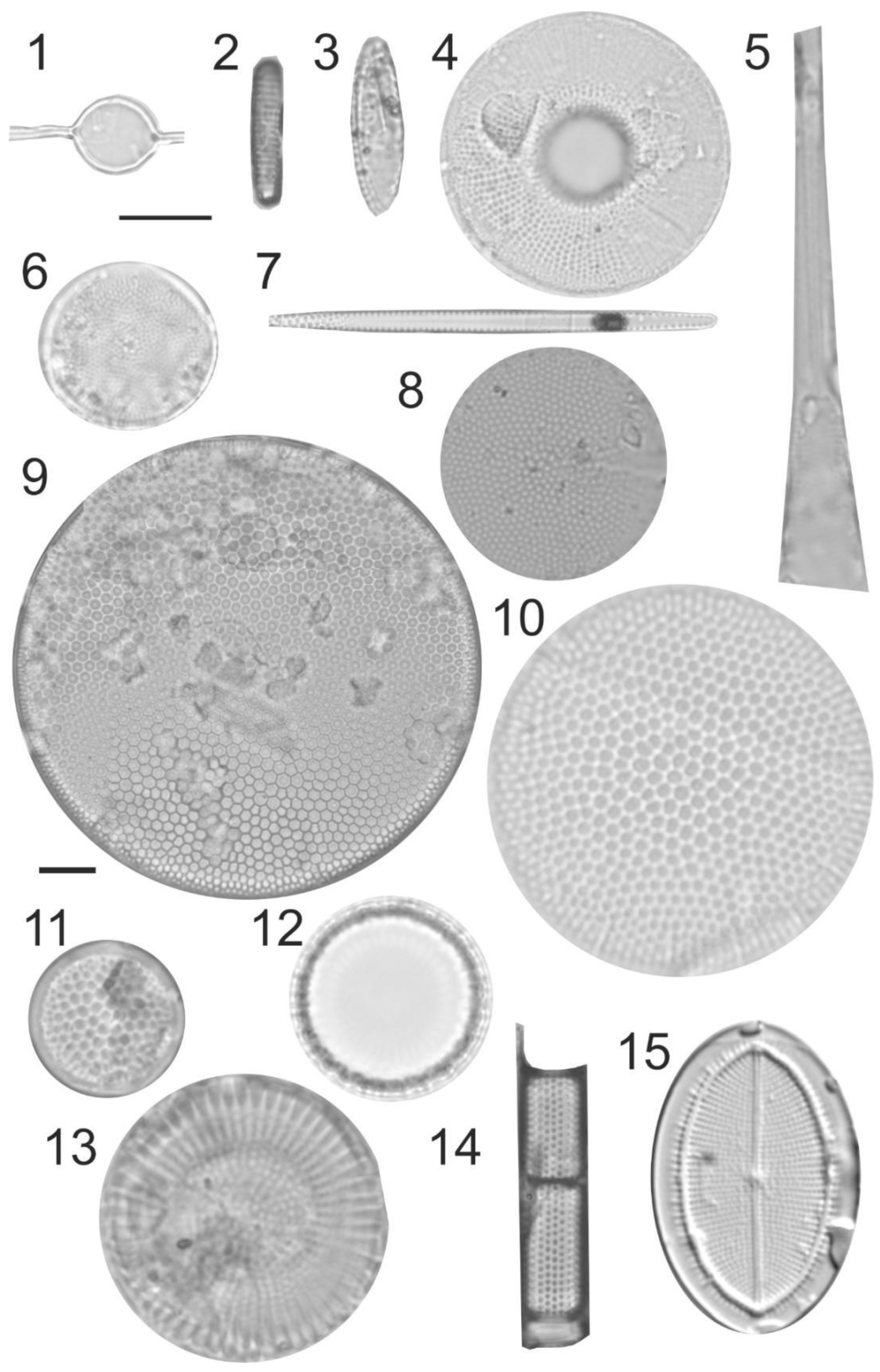

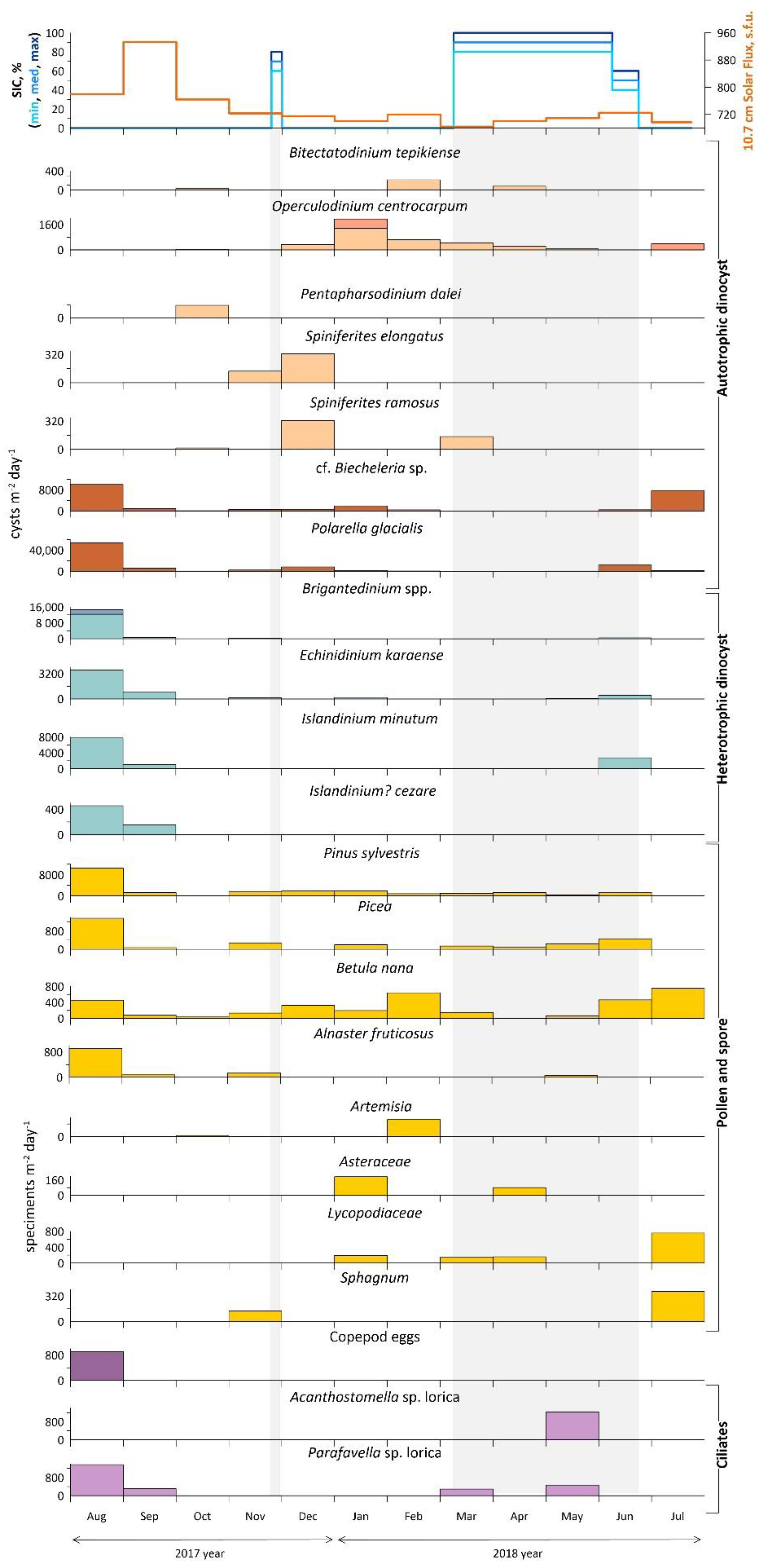
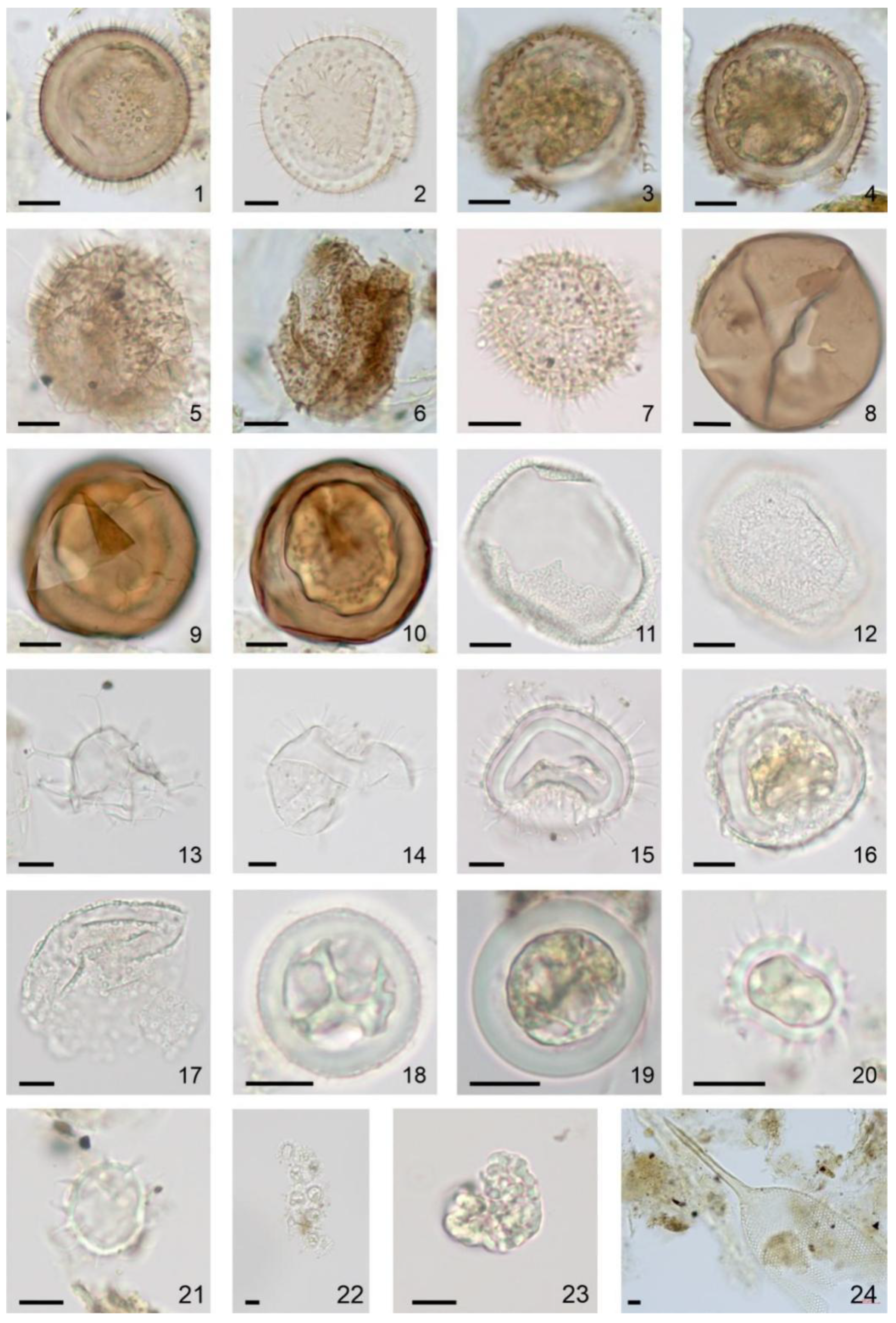

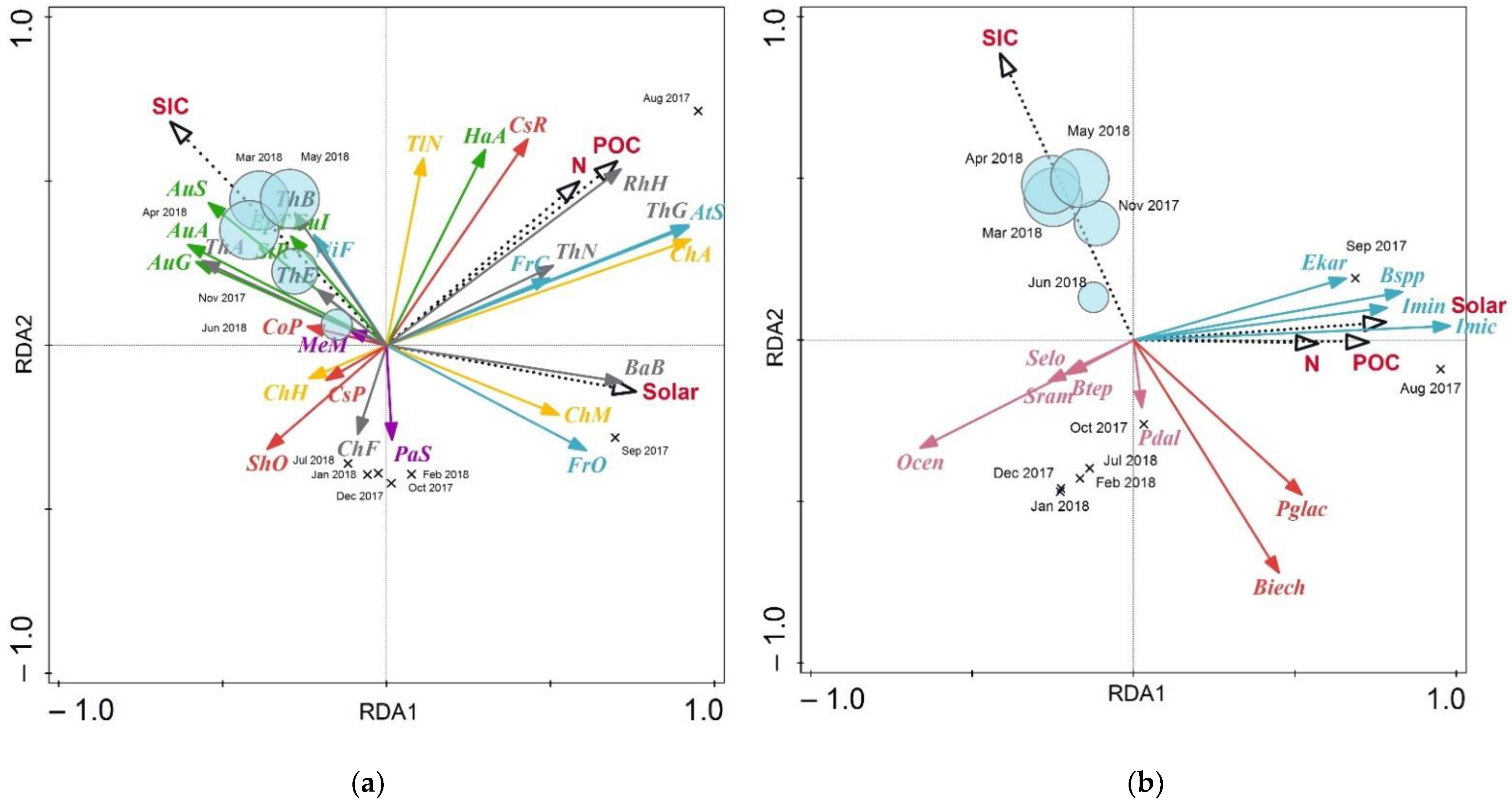
| Diatoms | Dinocyst | |||||||
|---|---|---|---|---|---|---|---|---|
| Statistic | Axis 1 | Axis 2 | Axis 3 | Axis 4 | Axis 1 | Axis 2 | Axis 3 | Axis 4 |
| Eigenvalues | 0.2754 | 0.1081 | 0.0732 | 0.0375 | 0.4105 | 0.1221 | 0.0402 | 0.0027 |
| Explained variation (cumulative) | 27.54 | 38.34 | 45.66 | 49.42 | 41.05 | 53.25 | 57.27 | 57.54 |
| Pseudo-canonical correlation | 0.91 | 0.8288 | 0.8141 | 0.8464 | 0.8373 | 0.923 | 0.8743 | 0.2902 |
| Explained fitted variation (cumulative) | 55.73 | 77.59 | 92.4 | 100 | 71.33 | 92.54 | 99.52 | 100 |
| Environmental Parameters | Diatoms | Dinocyst | ||
|---|---|---|---|---|
| Axis 1 | Axis 2 | Axis 1 | Axis 2 | |
| SIC, % | −0.6007 | 0.5637 | −0.3469 | 0.8181 |
| POC, mg C m−2 day−1 | 0.6391 | 0.4647 | 0.6089 | −0.006 |
| Solar, s.f.u. | 0.6912 | −0.1166 | 0.6539 | 0.0513 |
| N, mg m−2 day−1 | 0.5344 | 0.4138 | 0.4782 | −0.0095 |
Disclaimer/Publisher’s Note: The statements, opinions and data contained in all publications are solely those of the individual author(s) and contributor(s) and not of MDPI and/or the editor(s). MDPI and/or the editor(s) disclaim responsibility for any injury to people or property resulting from any ideas, methods, instructions or products referred to in the content. |
© 2022 by the authors. Licensee MDPI, Basel, Switzerland. This article is an open access article distributed under the terms and conditions of the Creative Commons Attribution (CC BY) license (https://creativecommons.org/licenses/by/4.0/).
Share and Cite
Agafonova, E.; Novichkova, E.; Novigatsky, A.; Kravchishina, M.; Klyuvitkin, A.; Bulokhov, A. Diatom and Dinocyst Production, Composition and Flux from the Annual Cycle Sediment Trap Study in the Barents Sea. Geosciences 2023, 13, 1. https://doi.org/10.3390/geosciences13010001
Agafonova E, Novichkova E, Novigatsky A, Kravchishina M, Klyuvitkin A, Bulokhov A. Diatom and Dinocyst Production, Composition and Flux from the Annual Cycle Sediment Trap Study in the Barents Sea. Geosciences. 2023; 13(1):1. https://doi.org/10.3390/geosciences13010001
Chicago/Turabian StyleAgafonova, Elizaveta, Ekaterina Novichkova, Alexander Novigatsky, Marina Kravchishina, Alexey Klyuvitkin, and Anton Bulokhov. 2023. "Diatom and Dinocyst Production, Composition and Flux from the Annual Cycle Sediment Trap Study in the Barents Sea" Geosciences 13, no. 1: 1. https://doi.org/10.3390/geosciences13010001
APA StyleAgafonova, E., Novichkova, E., Novigatsky, A., Kravchishina, M., Klyuvitkin, A., & Bulokhov, A. (2023). Diatom and Dinocyst Production, Composition and Flux from the Annual Cycle Sediment Trap Study in the Barents Sea. Geosciences, 13(1), 1. https://doi.org/10.3390/geosciences13010001









